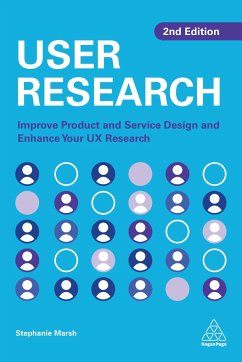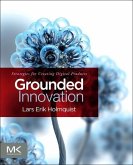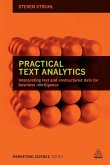- Gebundenes Buch
- Merkliste
- Auf die Merkliste
- Bewerten Bewerten
- Teilen
- Produkt teilen
- Produkterinnerung
- Produkterinnerung
Put the consumer back into the heart of your campaigns with this bestselling guide to user experience and research, offering practical and straightforward advice on the most up-to-date research methods.
Andere Kunden interessierten sich auch für
![The Brand Strategy Canvas The Brand Strategy Canvas]() Patrick WoodsThe Brand Strategy Canvas33,99 €
Patrick WoodsThe Brand Strategy Canvas33,99 €![Creative Business and Social Innovations for a Sustainable Future Creative Business and Social Innovations for a Sustainable Future]() Creative Business and Social Innovations for a Sustainable Future184,99 €
Creative Business and Social Innovations for a Sustainable Future184,99 €![Venture Capital Venture Capital]() Armin Höll-SteinerVenture Capital74,60 €
Armin Höll-SteinerVenture Capital74,60 €![Financial Return Risk and the Effect on Shareholder Wealth Financial Return Risk and the Effect on Shareholder Wealth]() Malte RaudszusFinancial Return Risk and the Effect on Shareholder Wealth68,95 €
Malte RaudszusFinancial Return Risk and the Effect on Shareholder Wealth68,95 €![ReWork ReWork]() Jason FriedReWork12,90 €
Jason FriedReWork12,90 €![Grounded Innovation Grounded Innovation]() Lars Erik HolmquistGrounded Innovation29,99 €
Lars Erik HolmquistGrounded Innovation29,99 €![Practical Text Analytics Practical Text Analytics]() Steven StruhlPractical Text Analytics43,99 €
Steven StruhlPractical Text Analytics43,99 €-
-
-
Put the consumer back into the heart of your campaigns with this bestselling guide to user experience and research, offering practical and straightforward advice on the most up-to-date research methods.
Produktdetails
- Produktdetails
- Verlag: Kogan Page
- 2nd edition
- Seitenzahl: 344
- Erscheinungstermin: 22. Februar 2022
- Englisch
- Abmessung: 234mm x 156mm x 27mm
- Gewicht: 662g
- ISBN-13: 9781398603608
- ISBN-10: 1398603600
- Artikelnr.: 61960569
- Verlag: Kogan Page
- 2nd edition
- Seitenzahl: 344
- Erscheinungstermin: 22. Februar 2022
- Englisch
- Abmessung: 234mm x 156mm x 27mm
- Gewicht: 662g
- ISBN-13: 9781398603608
- ISBN-10: 1398603600
- Artikelnr.: 61960569
Stephanie Marsh (she/they) is a leading UX research professional and currently UX Research Operations Lead at Springer Nature. They are the former Head of User Research and Analysis for the UK Government Digital Service and former Head of Digital Strategy for the UK Ministry of Defence. She was also previously a consultant at Bunnyfoot, a leading UX consultancy in the UK. They have contributed chapters to a range of peer-reviewed texts in related fields and has delivered talks on UX Research, Research Operations and UX strategies at a range of conferences and industry events. She is based in London.
Chapter
01: Introduction
Why is user research so important?; Section
ONE: The fundamentals
What good research looks like; Chapter
02: Planning, objectives and legalities in user research; Chapter
03: Best practice in user research
Who, what, why and how; Chapter
04: Managing user research logistics
Agencies, facilities and contracts; Section
TWO: Selecting and using user research methods; Chapter
05: Usability testing
Observing people doing things; Chapter
06: Content testing
What do people think your content means?; Chapter
07: Card sorting
Understanding how people group and relate things; Chapter
08: Surveys
How to gauge a widespread user response; Chapter
09: User interviews
Understanding people's experience through talking to them; Chapter
10: Diary studies
How to capture user research data over time; Chapter
11: Information architecture validation
Does the structure of your information work for your users?; Chapter
12: Ethnography
Observing how people behave in the real world; Chapter
13: Contextual inquiry
Interviewing people in their own environment; Chapter
14: A/B Testing
A technique to compare different options; Chapter
15: Getting the best out of stakeholder workshops; Chapter
16: Guerrilla research
Running fast
paced research in the real world; Chapter
17: How to combine user research methodologies; Section
THREE: Analyzing and presenting your data; Chapter
18: Content analysis
A method of coding and making sense of your qualitative data; Chapter
19: Affinity diagramming
Understand your data through identifying its themes; Chapter
20: Prioritizing issues and user needs
What's important and what to work on next; Chapter
21: Making recommendations
How to make your research findings actionable; Chapter
22: Creating executive summaries and detailed reports to present results; Chapter
23: Using video playback to present your research results; Chapter
24: Using personas to communicate user characteristics and behaviours; Chapter
25: Using mental models to visualize how users think and identify opportunities; Chapter
26: Using journey and experience maps to visualize user research data; Chapter
27: Using scenarios and storyboards to represent the user journey; Chapter
28: Using infographics to translate numerical and statistical data; Chapter
29: How to recommend changes to visual, interaction and information design; Chapter
30: Conclusion
01: Introduction
Why is user research so important?; Section
ONE: The fundamentals
What good research looks like; Chapter
02: Planning, objectives and legalities in user research; Chapter
03: Best practice in user research
Who, what, why and how; Chapter
04: Managing user research logistics
Agencies, facilities and contracts; Section
TWO: Selecting and using user research methods; Chapter
05: Usability testing
Observing people doing things; Chapter
06: Content testing
What do people think your content means?; Chapter
07: Card sorting
Understanding how people group and relate things; Chapter
08: Surveys
How to gauge a widespread user response; Chapter
09: User interviews
Understanding people's experience through talking to them; Chapter
10: Diary studies
How to capture user research data over time; Chapter
11: Information architecture validation
Does the structure of your information work for your users?; Chapter
12: Ethnography
Observing how people behave in the real world; Chapter
13: Contextual inquiry
Interviewing people in their own environment; Chapter
14: A/B Testing
A technique to compare different options; Chapter
15: Getting the best out of stakeholder workshops; Chapter
16: Guerrilla research
Running fast
paced research in the real world; Chapter
17: How to combine user research methodologies; Section
THREE: Analyzing and presenting your data; Chapter
18: Content analysis
A method of coding and making sense of your qualitative data; Chapter
19: Affinity diagramming
Understand your data through identifying its themes; Chapter
20: Prioritizing issues and user needs
What's important and what to work on next; Chapter
21: Making recommendations
How to make your research findings actionable; Chapter
22: Creating executive summaries and detailed reports to present results; Chapter
23: Using video playback to present your research results; Chapter
24: Using personas to communicate user characteristics and behaviours; Chapter
25: Using mental models to visualize how users think and identify opportunities; Chapter
26: Using journey and experience maps to visualize user research data; Chapter
27: Using scenarios and storyboards to represent the user journey; Chapter
28: Using infographics to translate numerical and statistical data; Chapter
29: How to recommend changes to visual, interaction and information design; Chapter
30: Conclusion
- Chapter - 01: Introduction - Why is user research so important?;
- Section - ONE: The fundamentals - What good research looks like;
- Chapter - 02: Planning, objectives and legalities in user research;
- Chapter - 03: Best practice in user research - Who, what, why and how;
- Chapter - 04: Managing user research logistics - Agencies, facilities and contracts;
- Section - TWO: Selecting and using user research methods;
- Chapter - 05: Usability testing - Observing people doing things;
- Chapter - 06: Content testing - What do people think your content means?;
- Chapter - 07: Card sorting - Understanding how people group and relate things;
- Chapter - 08: Surveys - How to gauge a widespread user response;
- Chapter - 09: User interviews - Understanding people's experience through talking to them;
- Chapter - 10: Diary studies - How to capture user research data over time;
- Chapter - 11: Information architecture validation - Does the structure of your information work for your users?;
- Chapter - 12: Ethnography - Observing how people behave in the real world;
- Chapter - 13: Contextual inquiry - Interviewing people in their own environment;
- Chapter - 14: A/B Testing - A technique to compare different options;
- Chapter - 15: Getting the best out of stakeholder workshops;
- Chapter - 16: Guerrilla research - Running fast-paced research in the real world;
- Chapter - 17: How to combine user research methodologies;
- Section - THREE: Analyzing and presenting your data;
- Chapter - 18: Content analysis - A method of coding and making sense of your qualitative data;
- Chapter - 19: Affinity diagramming - Understand your data through identifying its themes;
- Chapter - 20: Prioritizing issues and user needs - What's important and what to work on next;
- Chapter - 21: Making recommendations - How to make your research findings actionable;
- Chapter - 22: Creating executive summaries and detailed reports to present results;
- Chapter - 23: Using video playback to present your research results;
- Chapter - 24: Using personas to communicate user characteristics and behaviours;
- Chapter - 25: Using mental models to visualize how users think and identify opportunities;
- Chapter - 26: Using journey and experience maps to visualize user research data;
- Chapter - 27: Using scenarios and storyboards to represent the user journey;
- Chapter - 28: Using infographics to translate numerical and statistical data;
- Chapter - 29: How to recommend changes to visual, interaction and information design;
- Chapter - 30: Conclusion
Chapter
01: Introduction
Why is user research so important?; Section
ONE: The fundamentals
What good research looks like; Chapter
02: Planning, objectives and legalities in user research; Chapter
03: Best practice in user research
Who, what, why and how; Chapter
04: Managing user research logistics
Agencies, facilities and contracts; Section
TWO: Selecting and using user research methods; Chapter
05: Usability testing
Observing people doing things; Chapter
06: Content testing
What do people think your content means?; Chapter
07: Card sorting
Understanding how people group and relate things; Chapter
08: Surveys
How to gauge a widespread user response; Chapter
09: User interviews
Understanding people's experience through talking to them; Chapter
10: Diary studies
How to capture user research data over time; Chapter
11: Information architecture validation
Does the structure of your information work for your users?; Chapter
12: Ethnography
Observing how people behave in the real world; Chapter
13: Contextual inquiry
Interviewing people in their own environment; Chapter
14: A/B Testing
A technique to compare different options; Chapter
15: Getting the best out of stakeholder workshops; Chapter
16: Guerrilla research
Running fast
paced research in the real world; Chapter
17: How to combine user research methodologies; Section
THREE: Analyzing and presenting your data; Chapter
18: Content analysis
A method of coding and making sense of your qualitative data; Chapter
19: Affinity diagramming
Understand your data through identifying its themes; Chapter
20: Prioritizing issues and user needs
What's important and what to work on next; Chapter
21: Making recommendations
How to make your research findings actionable; Chapter
22: Creating executive summaries and detailed reports to present results; Chapter
23: Using video playback to present your research results; Chapter
24: Using personas to communicate user characteristics and behaviours; Chapter
25: Using mental models to visualize how users think and identify opportunities; Chapter
26: Using journey and experience maps to visualize user research data; Chapter
27: Using scenarios and storyboards to represent the user journey; Chapter
28: Using infographics to translate numerical and statistical data; Chapter
29: How to recommend changes to visual, interaction and information design; Chapter
30: Conclusion
01: Introduction
Why is user research so important?; Section
ONE: The fundamentals
What good research looks like; Chapter
02: Planning, objectives and legalities in user research; Chapter
03: Best practice in user research
Who, what, why and how; Chapter
04: Managing user research logistics
Agencies, facilities and contracts; Section
TWO: Selecting and using user research methods; Chapter
05: Usability testing
Observing people doing things; Chapter
06: Content testing
What do people think your content means?; Chapter
07: Card sorting
Understanding how people group and relate things; Chapter
08: Surveys
How to gauge a widespread user response; Chapter
09: User interviews
Understanding people's experience through talking to them; Chapter
10: Diary studies
How to capture user research data over time; Chapter
11: Information architecture validation
Does the structure of your information work for your users?; Chapter
12: Ethnography
Observing how people behave in the real world; Chapter
13: Contextual inquiry
Interviewing people in their own environment; Chapter
14: A/B Testing
A technique to compare different options; Chapter
15: Getting the best out of stakeholder workshops; Chapter
16: Guerrilla research
Running fast
paced research in the real world; Chapter
17: How to combine user research methodologies; Section
THREE: Analyzing and presenting your data; Chapter
18: Content analysis
A method of coding and making sense of your qualitative data; Chapter
19: Affinity diagramming
Understand your data through identifying its themes; Chapter
20: Prioritizing issues and user needs
What's important and what to work on next; Chapter
21: Making recommendations
How to make your research findings actionable; Chapter
22: Creating executive summaries and detailed reports to present results; Chapter
23: Using video playback to present your research results; Chapter
24: Using personas to communicate user characteristics and behaviours; Chapter
25: Using mental models to visualize how users think and identify opportunities; Chapter
26: Using journey and experience maps to visualize user research data; Chapter
27: Using scenarios and storyboards to represent the user journey; Chapter
28: Using infographics to translate numerical and statistical data; Chapter
29: How to recommend changes to visual, interaction and information design; Chapter
30: Conclusion
- Chapter - 01: Introduction - Why is user research so important?;
- Section - ONE: The fundamentals - What good research looks like;
- Chapter - 02: Planning, objectives and legalities in user research;
- Chapter - 03: Best practice in user research - Who, what, why and how;
- Chapter - 04: Managing user research logistics - Agencies, facilities and contracts;
- Section - TWO: Selecting and using user research methods;
- Chapter - 05: Usability testing - Observing people doing things;
- Chapter - 06: Content testing - What do people think your content means?;
- Chapter - 07: Card sorting - Understanding how people group and relate things;
- Chapter - 08: Surveys - How to gauge a widespread user response;
- Chapter - 09: User interviews - Understanding people's experience through talking to them;
- Chapter - 10: Diary studies - How to capture user research data over time;
- Chapter - 11: Information architecture validation - Does the structure of your information work for your users?;
- Chapter - 12: Ethnography - Observing how people behave in the real world;
- Chapter - 13: Contextual inquiry - Interviewing people in their own environment;
- Chapter - 14: A/B Testing - A technique to compare different options;
- Chapter - 15: Getting the best out of stakeholder workshops;
- Chapter - 16: Guerrilla research - Running fast-paced research in the real world;
- Chapter - 17: How to combine user research methodologies;
- Section - THREE: Analyzing and presenting your data;
- Chapter - 18: Content analysis - A method of coding and making sense of your qualitative data;
- Chapter - 19: Affinity diagramming - Understand your data through identifying its themes;
- Chapter - 20: Prioritizing issues and user needs - What's important and what to work on next;
- Chapter - 21: Making recommendations - How to make your research findings actionable;
- Chapter - 22: Creating executive summaries and detailed reports to present results;
- Chapter - 23: Using video playback to present your research results;
- Chapter - 24: Using personas to communicate user characteristics and behaviours;
- Chapter - 25: Using mental models to visualize how users think and identify opportunities;
- Chapter - 26: Using journey and experience maps to visualize user research data;
- Chapter - 27: Using scenarios and storyboards to represent the user journey;
- Chapter - 28: Using infographics to translate numerical and statistical data;
- Chapter - 29: How to recommend changes to visual, interaction and information design;
- Chapter - 30: Conclusion
"This book offers a comprehensive overview of how to be a great user researcher and explains exactly how to plan, run and debrief impactful user research. This new edition is right up to date with modern research needs for ethical data handling, and operationalising research. An essential handbook for new and experienced researchers to keep by their side!" Steve Bromley, Principal User Researcher at Reach PLC and author of Building User Research Teams and How To Be A Games User Researcher








